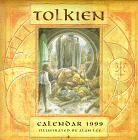1999 Tolkien Calendar

The 1999 J.R.R. Tolkien Calendar. Illustrated by Alan Lee. HarperPrism, New York. ISBN 0-06-105591-3. $12.99 U. S./$19.00 Canadian.

Reviewed by Paula DiSante
The Graying of Middle-earth
HarperCollins once again features Alan Lee as artist for the 1999 version of the long-running Tolkien Calendar. But in truth, Lee’s paintings here are not new, being culled from the 1997 re-release of The Hobbit which he illustrated. Lee, a seeming favorite of the HarperCollins editors, perhaps because he is a home-grown Englishman, also served as illustrator for the one-volume special edition of The Lord of the Rings, which was published in 1991. In the intervening years, Lee has markedly improved the visual drama of his work, which was lacking, for the most part, in his Lord of the Rings illustrations. He now has less timidity in portraying Tolkien’s characters, and in general picks his scenes more wisely.
What has not improved is Lee’s watercolor palette, which remains a dreary mélange of grayish-blues, grayish-browns, grayish-greens, grayish-yellows and, of course, the ever-popular gray. Although appropriate enough for January’s night scene of the Dwarves and Bilbo clinging precariously to pine trees as menacing Wargs lurk below, or for February’s Desolation of Smaug before the Front Gate of the Lonely Mountain, this palette is a detriment to the otherwise well-drawn June illustration of the Carrock and the wide countryside surrounding it.
While effective for December’s Burial of Thorin, the grayness ultimately drains out the visual punch from Smaug’s violent, fiery attack upon the Mountain (November), in what is an otherwise dynamic piece. It does no favors, either, for August’s painting of the arrival of Thorin and Company, tumbled on the floor of the entrance hall at Bag End. The hall could nearly double for an abandoned chamber in the dwarf-delved, bleak depths of Erebor, rather than a cheery hobbit hole.
The publishers seem to find it necessary to apologize, in a way, for this very thing. The biographical notes for the artist, printed inside the calendar, proudly state that Lee works “in delicate, misty shades,” and that his paintings have an “ethereal quality” which is “perfectly suited to the portrayal of Tolkien’s Middle-earth.” “Perfectly suited” stretches the limits of credibility. Since avid readers more often than not cite the vivid reality of Tolkien’s world as the chief reason for their abiding devotion, this statement carries the odor of excuse-making, as if to justify the expense of what is supposed to be — and what is sold as — a full-color calendar.
That aside, however, Lee’s forward progress in dramatic presentation is notable. April offers an enraged Thorin defending the fortified Front Gate, adamant that none should win a single gold coin from his newly-reacquired treasure without a fight. The tension is there — if not in living color, then in the drawing of the character himself. The aforementioned Burial of Thorin exudes a somber majesty, and March’s painting, depicting the hapless Dwarves ensnared aloft in the spiders’ webs in Mirkwood, elicits both amusement and fear.
Lee’s Bilbo, while oddly lanky (for a hobbit), remains consistently drawn throughout. But Lee’s orcs are more fanciful and fairy tale-ish in some pictures than Tolkien ever described. The appearance of a demon-like infant orc in the painting of the Dwarves before the Great Goblin (October) is utterly out of place. May’s scene of the Dwarves leading their ponies over a stone bridge and July’s view of the forest entrance to the Elvenking’s halls do not particularly distinguish themselves. But September’s painting is one of the best depictions of Lake-town yet, if one overlooks its desaturated state.
HarperCollins, perhaps mindful of the obvious lack of color in the primary artwork, has included some of Lee’s Hobbit pencil drawings to distract the viewer from that fact. They are visible like fine silverpoints beneath the monthly gridlines, which are themselves slender and unobtrusive. The drawings provide the best art in the calendar, and clearly it is in pencil work that Lee’s real talent lies. The layout and typefaces are clean and understated, a tasteful change from some previous editions. Included also is a centerfold of Gandalf, Bilbo and the Dwarves studying Thror’s map, and touted on the back of the calendar as a free poster. But the “poster” is backed by the monthly grid of June and the artwork of July, and removal of it to hang on a wall would render the calendar useless next summer.
In spite of such niggling nuisances, there is more than enough to recommend this year’s calendar. One could hope that in the future HarperCollins would commission all-new art, rather than reprinting work that has already seen publication in another format. But this is an old complaint likely to fall on deaf ears. It is best to remain grateful that the publisher sees fit every year to issue a new Tolkien calendar. May that tradition long continue.
